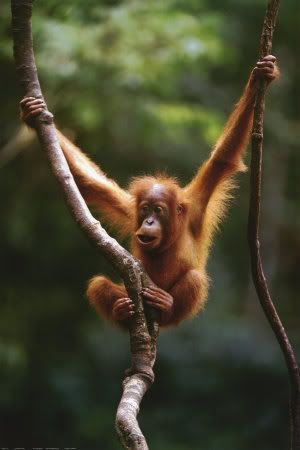Spanish Apes May Have Been the First Swingers
Ancestors to modern orang-utans?
A new study in Proceedings B has found that an ancient ape from Catalonia, Spain was both a tree-walker and tree-swinger suggesting that this species could show the transitional period when apes were adapting to a life brachiating through the forest canopy.
The latest issue of New Scientist explains that the
9.5-million-year-old fossil of the ape Hispanopithecus laietanus reveals that it had fingers that were longer than those of a modern gorilla or human, but not as long as those of an orang-utan: an arrangement of bones unique among all known apes, alive or extinct. That would have allowed it to hang from tree branches as orang-utans do, but also walk on all fours along the larger branches with its palms flat on the surface.
The authors state that their study's results
reveal many similarities with extant orang-utans (Pongo). These similarities are interpreted as adaptations to below-branch suspensory behaviours, including arm-swinging and clambering/postural feeding on slender arboreal supports, due to an orang-like double-locking mechanism.
According to genetic evidence, our common ancestor with orang-utans lived approximately 18 million years ago. The current study’s findings are inconclusive as to whether H. laietanus was an ancestor of modern orang-utans or whether they were an evolutionary dead-end.
Reference:
S. Almécija, D.M. Alba, S. Moyà-Solà, and M. Köhler (2007). Orang-like manual adaptations in the fossil hominoid Hispanopithecus laietanus: first steps towards great ape suspensory behaviours. Proceedings of the Royal Society B: Biological Sciences 274(1622)


















No comments:
Post a Comment